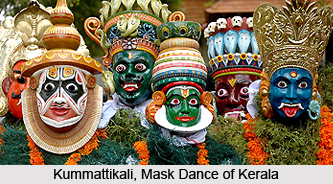 Kummattikali is a folk dance that is performed in Kerala. It is seen that during the festival of Onam, the performers move from house to house entertaining people. These dancers are seen mainly in Thrissur District and portions of Malabar Coast and are beautiful mask dances.
Kummattikali is a folk dance that is performed in Kerala. It is seen that during the festival of Onam, the performers move from house to house entertaining people. These dancers are seen mainly in Thrissur District and portions of Malabar Coast and are beautiful mask dances.
The original form of Kummattikali can be seen in the Bhadrakali temple of Palghat district. A legend of Lord Shiva is also associated with this dance. They collect jaggery, rice or small amounts of cash while moving from house to house. Kummattikali is a devotional art form of Kerala.
Costumes of Kummattikali Dance
The costumes worn by the Kummattikali dancers are an interesting aspect of the dance. The dancers wear a heavily painted colourful wooden mask that depicts the faces of Krishna, Narada, Kiratha, Darika. These masks are made out of saprophyte, jack fruit tree, Alstonia scholaris, Hog Plum tree or the Coral tree. Skirts woven out of plaited grass are also worn. Some of the dancers cover their whole body with bunches of grass in order to lend a bushy appearance. The "talla" attached to the mask and it gives the appearance of a toothless open mouth. Dancers hold and manipulate long sticks of residuary agricultural produce called `Kummattikali`. From this the dance derives its name. Kummattikali dance is associated with a Shaiva mythological legend. As per this legend, an old woman named `Thamma` walks with the aide of a stick and this lady signifies `mother` of every living creature.
Performance of Kummattikali Dance
The dancers move from one house to the next, and collect amounts of cash, rice and jaggery. The dance rhythm is provided by vibrating the string of a bow like instrument known as `Onavillu`. Areca nut wood is used in order to make the bow and the strings. These strings are beaten with a narrow bamboo stick. Various themes of this form of dance are adapted from tales of `Darika Vadham`, Ramayana, Manjan Nayare Pattu and the story of Lord Shiva. This dance is performed in the honour of a regional God and Goddess and several magical arts.




